
Atlas F1 Technical Writer
With no time to test since Monaco, and with the Nurburgring not presenting a big challenge to the teams, the European Grand Prix did not see many technical advances for the race. Atlas F1's Craig Scarborough analyses the changes seen during last weekend's race and reviews the cars' performance
McLaren MP4-19B Testing Debut
On Tuesday after the European Grand Prix, McLaren rolled out their revised MP4-19B in a secretive and low-key launch. The new car uses around 50% new parts. The initial runs were short but reliable, and the team's confidence with the new car was clearly apparent.
Mercedes Ilmor are working through problems with the engines castings and electronics, two areas where the power train has invited technical problems. The chassis design team, lead by Adrian Newey and Mike Coughlan, have re-examined the chassis and aero side, the latter area now bolstered by Ferrari stalwart Nicolas Tombasis. Since its roll out in November 2003 and the installation of the definitive engine package during winter testing the car's pace has faltered. Corner entry stability has been pinpointed as an area of weakness; this not only limits actual pace but saps driver confidence, slowing lap times even further.
Particularly affected by this is David Coulthard, who has struggled to race a long line of recent McLarens sensitive to an accurate set up. Whether the handling problems are from the front or rear is not clear to those outside the team, but chassis stiffness and weight transfer control are critical factors. McLaren have not run their carbon gearbox on the 19, and are still using a twin keel front end; both these designs have major stiffness/weight issues.
The resulting MP4-19B car is almost indiscernible from its predecessor; there are a few external changes, but you would probably need an X-ray machine to detect the real changes. The key change, though, is not hidden under the bodywork, but is in the construction of the monocoque itself. One of the areas the still born MP4-18 pioneered was a super light carbon fibre lay up; this was believed to be too weak to withstand the vibrations of the engine and lead to major structural failures.
While the structure of the MP4-19 has been reliable, the trade off in weight and stiffness has been addressed once more in the lay up of the B spec car. The changes to the plies of carbon fibre in chassis construction have been so substantial that new crash tests were required, greatly adding to the cost of the interim car project. In its external shape the monocoque does not vary greatly from the 19; the twin keel are retained, still using a strut to reinforce them rather than adding weight with extra carbon fibre to stop the keels flexing under load.
McLaren have been reticent to reveal how far engine and gearbox changes have gone in the new car. It is most likely that some, but not substantial redesigns have occurred.
The reshaped sidepod inlet suggests a new radiator layout has been adopted, while the internal ducting and grills imply a stepped layout, as the oil cooler can be placed in the narrower lower part of the sidepod, leaving the larger water radiator to fill the upper part. Cooling outlets are consistent with the MP4-19.
Novelties on the car are the winglets that now feature two elements, with the slot between the pair starting halfway up the vertical mount. Also the line of the engine cover has altered, with a flatter line behind the roll hoop, prompting speculation that a mid wing is a consideration for the future.
Team by Team
Ferrari
Retaining their angled cooling chimneys, the cars appeared in familiar guise this weekend. Unusually Friday brought technical problems, with Michael Schumacher's running hampered by a hydraulic problem; Rubens Barrichello had to make up for lost time by doing all the tyre comparison work himself. Bridgestone's tyre choice provided the teams with "one tyre that has better performance over the opening lap and is less consistent, and the second where the opposite applies"; with this in mind Ferrari's concern over tyres in qualifying exposed their tyre choice, as they were apprehensive about their one lap pace.
As a result the recent strategy to split race fuel loads was repeated, with Schumacher running very light and Barrichello heavier; Schumacher's flawless lap in Q2 actually brought a faster time than expected. With the benefit of hindsight the team would have run him heavier for the longer opening stint, despite the lightweight Shell fuel. The split fuel strategy saw Schumacher pit first in the race, leaving Barrichello to run out of sequence after his later first (of two) stop. Both strategies worked out, as Schumacher was able to make as good a start as his rivals to keep the lead into turn 1, while Barrichello lost out somewhat with his heavier fuelled car. After the final stops were made he came through into second to follow Schumacher home once more.
Renault
Friday and Saturday where clean, problem free days for both drivers. Their usual excellent starts weren't apparent on Sunday when both drivers passed on the opening laps. Later in the race Fernando Alonso's steering problems caused a few off track excursions, but he was still able to make up time when others were struggling with their tyres.
BAR
BAR ran a similar spec to recent races, with their complex rear wing endplates in use as well as the extra mid and shelf wing. Friday went without drama, although all the drivers complained of a lack of grip and balance. Jenson Button's inconsistent grip cost him in sector 1 of his second qualifying run, whereas Takuma Sato's lap was cleaner than his usual form, posting him on the front row for Sunday. Button's indiscretion on his lap forced the team to change the floor in parc ferme.
Williams
Still racing with the strut reinforcing the water wing in front of the sidepods, the car was otherwise in familiar spec. Ralf Schumacher initially reacted better to the dusty track on Friday; while Juan Pablo Montoya struggled with poor balance. As the weekend progressed the team still struggled with the car, and qualifying left the team at the back of the top ten.
At the race start both Williams were able to gain on the front of the grid, but were both caught out by the field braking into turn 1; both drivers locked up and tangled with the Toyotas, forcing Ralf Schumacher out on the spot and Montoya into the pits for a new nose. He fought on with fading rear tyres to race end for a single championship point.
McLaren
After a dismal Monaco race weekend some pace from the car was welcomed; it was not a breakthrough on the chassis, but merely the circuit not punishing the car's corner entry instability. This was reflected in the team's pace in Friday's opening sessions. The team's pace was carried over into Saturday, with Kimi Raikkonen up in fourth. The first sign of trouble occurred when Coulthard's car had an engine problem after his Q1 run, forcing him to change an engine and sit out qualifying.
Both cars had bargeboard parts replaced in parc ferme, along with Coulthard's engine, plank and some miscellaneous parts. With Coulthard on a fuel heavy two stop strategy he was able to make up ground though the midfield, while Raikkonen pressed on towards the front. Nevertheless, this improved pace was soon curtailed by two engine failures, believed to traceable to a faulty supply of pistons.
Jaguar
Christian Klien had an off on Friday, while Bjorn Wirdheim had a fuel leak; Mark Webber was happy with the cars balance, even if his pace was out of the top ten. For Saturday the balance was matched with improved pace for both cars; only Webber's yellow flag infringement on Friday (resulting in a one second penalty) pushed him down the grid. Klien was allowed to replace some bodywork parts in parc ferme, including his front wing endplate and a bargeboard bracket. At the race start Webber suffered yet another problematic getaway, no doubt aided by his two-stop fuel load, but both cars did race to the finish and a welcome return to reliability.
Sauber
It was not a good start to the team's race weekend when on Friday Giancarlo Fisichella's engine failed and Felipe Massa's electrics stranded him on track. Fisichella decided not to run in the qualifying session, preferring instead to start from the back of the grid, while Massa's error on his Q2 lap cost him some time. As Giancarlo was able to start with a full load of fuel he ran a long opening stint, and then pressed on to finish in the points. Massa struggled with front wing damage to finish out of the points.
Toyota
As the team continue to the develop the TF104, the B version is under development by designer John Lichen; the revised car is due at the British Grand Prix and will feature a new monocoque, redesigned to lower its weight and allow more ballast to be added to lower the centre of gravity. Visually the car will be similar to the current version, but will still require resubmission to the FIA crash tests. They will also have some new aerodynamic parts, but these are not expected to debut until the German Grand Prix, creating a phased roll out to the new car.
Underpinning the revised car will be the same mechanical rear end package; the engine, gearbox and suspension have been deemed reliable and effective enough not to require major redesign, a belief reinforced by their tyre partner Michelin, who are also helping the team revise the front suspension's camber geometry to further improve grip. Overall the team cite poor aerodynamic grip as their main failing.
All this work has been carried out under the management of Mike Gascoyne, who oversees the chassis and aero departments. Since his appointment Gascoyne has appointed Lichen to oversee the 2004 cars, while Gustav Brunner has moved on to the TF105 for next year. It is not expected that Toyota will run two alternating development teams, as Brunner's skills are believed best allocated to new car philosophies under Gascoyne's supervision
There was clean running for all three cars on Friday, with the only anxiety being high tyre degradation and Olivier Panis' lack of confidence in the handling. Set up work over night cleared up his worries, and qualifying placed the cars tenth and eleventh.
Cristiano da Matta was ejected from the race at the first corner as a result of the two Williams cars locking up. Panis, although involved in the incident, was undamaged and able to race on; he soon suffered from badly degrading Michelins, but otherwise had a reliable run to the flag.
Jordan
Progress over Friday and Saturday practice, as well as the qualifying sessions, saw the drivers top Sauber on the grid. The car's competitiveness on the Bridgestones carried over into the race, with only Giorgio Pantano's downshift problem spoiling their most convincing race this year.
Minardi
Having to pay for an engine supply must be tough when the team suffered two engine failures in second free practice on Saturday. Reliable races brought two finishes.
Unlike its classic predecessor the Nordshlieffe, the relatively young Nurburgring circuit is a typical modern track. Unimaginative in its use of chicanes and low-medium speed corners, it does not offer the driver much in the way of a technical challenge. Also, as the race comes on the back of the Monaco race, no testing has been carried out, and no real new technical developments were seen on the cars. With cooler weather the cars ran a closed cooling set up, and tyre choice was aimed at consistency as degradation was not expected to be high.
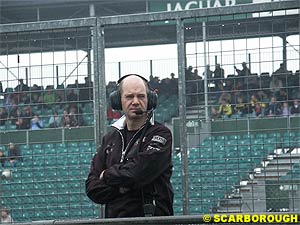 With the failure of the A versions of the last three McLarens, it was a brave and expensive move for McLaren to roll out a heavily re-engineered B version of the MP4-19 car. As the Nurburgring race proved the MP4-19 is not a reliable car; it has also failed to match the pace of the leading teams.
With the failure of the A versions of the last three McLarens, it was a brave and expensive move for McLaren to roll out a heavily re-engineered B version of the MP4-19 car. As the Nurburgring race proved the MP4-19 is not a reliable car; it has also failed to match the pace of the leading teams.
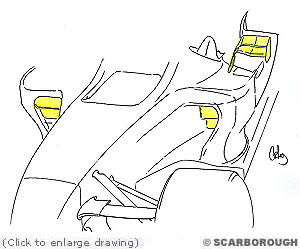 Visually the car differs from the 19 in the shape of the sidepods, now adopting Ferrari influenced undercuts over the trademark widely spaced vertical inlets of its descendants. The undercuts provide a cleaner path for the flow, splitting left and right over the shadow plate before passing under the flip ups. In adopting this shape many other areas have had to be redesigned; aerodynamically the bargeboards and shadow plate need to be part of the package. The bargeboard is still formed by three panels, with the most forward board being mounted to the twin keel and having a complex trailing edge.
Visually the car differs from the 19 in the shape of the sidepods, now adopting Ferrari influenced undercuts over the trademark widely spaced vertical inlets of its descendants. The undercuts provide a cleaner path for the flow, splitting left and right over the shadow plate before passing under the flip ups. In adopting this shape many other areas have had to be redesigned; aerodynamically the bargeboards and shadow plate need to be part of the package. The bargeboard is still formed by three panels, with the most forward board being mounted to the twin keel and having a complex trailing edge.
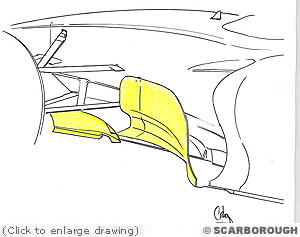 Some new small details on the Renault in Germany were the forward pair of barge boards, which have a curved trailing edge with a small vortex generator on its upper edge (pictured); also the front wing endplates now feature a small vertical lip on the foot plate. The engine installation has proven to be reinforced with the strut, as seen on last year's car; the tubular strut runs alongside the lower airbox and mounts to the cylinder head at the rear of the engine, albeit hidden behind the heat shielding.
Some new small details on the Renault in Germany were the forward pair of barge boards, which have a curved trailing edge with a small vortex generator on its upper edge (pictured); also the front wing endplates now feature a small vertical lip on the foot plate. The engine installation has proven to be reinforced with the strut, as seen on last year's car; the tubular strut runs alongside the lower airbox and mounts to the cylinder head at the rear of the engine, albeit hidden behind the heat shielding.
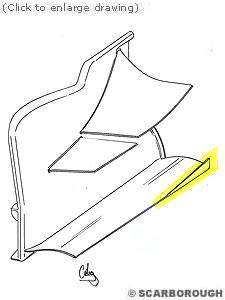 At the race start Sato made an equal start but was able to brake latest of all into turn 1 to gain places; this manoeuvre also ruined his race when he tried a late move on Barrichello for second, resulting in a broken front wing which forced him into the pits for an extended stop. This may have lead to his subsequent engine failure. Button had a slower start but fell behind back markers; with misfortune falling on others he was able to gain a podium place.
At the race start Sato made an equal start but was able to brake latest of all into turn 1 to gain places; this manoeuvre also ruined his race when he tried a late move on Barrichello for second, resulting in a broken front wing which forced him into the pits for an extended stop. This may have lead to his subsequent engine failure. Button had a slower start but fell behind back markers; with misfortune falling on others he was able to gain a podium place.
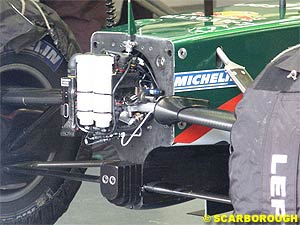 In a bid to sort out the car's handling a large amount of ballast was placed forward of the front bulkhead as low as possible. The resulting stack of ballast bolted to the keel was not in the ideal place, as most ballast is in the floor. This solution does, however, move the weight distribution much further forward for less ballast, notwithstanding the cost of a higher centre of gravity.
In a bid to sort out the car's handling a large amount of ballast was placed forward of the front bulkhead as low as possible. The resulting stack of ballast bolted to the keel was not in the ideal place, as most ballast is in the floor. This solution does, however, move the weight distribution much further forward for less ballast, notwithstanding the cost of a higher centre of gravity.
|
Contact the Author Contact the Editor |
Please Contact Us for permission to republish this or any other material from Atlas F1.
|
Volume 10, Issue 22
Atlas F1 Exclusive
Interview with Anthony Davidson
Bjorn Wirdheim: Going Places
Ann Bradshaw: Point of View
2004 European GP Review
2004 European GP Review
Technical Review: Europe 2004
Deutschland Unter Alles
Team Players
Stats Center
Qualifying Differentials
SuperStats
Charts Center
Columns
The F1 Insider
Season Strokes
Elsewhere in Racing
The Weekly Grapevine
> Homepage |